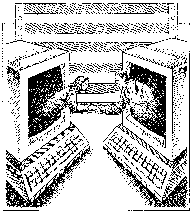|
Local Area Networks Allow Sharing Information
As personal computers became faster, more affordable, and were utilized in new ways, businesses found a need to have more than one personal computer in their office. Local Area Networks introduced a way to connect personal computers, enabling the sharing of information and other resources within an office.
Central to the LAN was one or more servers which ran Novell NetWare. Shared files and databases could be located on a server and accessed by users of other computers attached to the LAN. Printers could also be attached to the server and shared. In subsequent years, IBM, Microsoft and Apple also developed local area network, file and print server solutions. For example, a retail store has an order department, a receiving department, an accounting department, cashiers in the store, and a mail order shipping desk. All use personal computers that are attached to the store's local area network and have access to a common database. located on the server, that includes all of the items the store sells. When items are ordered, the database is updated by the order department, typically using the item's UPC. When the items arrive, the receiving department updates the inventory, as do the cashiers when an item is sold using the sales register software. The database will continue to have accurate information about the number of items available in the store, retail price, etc. The introduction of Microsoft Windows for Workgroups 3.11 in 1993 added peer-to-peer workgroup and domain networking support. Peer-to-peer networking allows computers in a small office or workgroup to share files and printers without requiring a server. Integrated networking was a key part of Windows NT 3.1 when it was introduced later the same year. Since the development of shared online computer resources, local computer networks have continued to evolve with improvements in network hardware and in software offered by Microsoft, Novell, IBM and Apple. Information has continued to become more accessible within a company. Today computers attached to a LAN can also share an Internet Gateway, allowing access to information from outside the organization, providing new opportunities to companies to locate information on the internet, from any computer within the organization that is configured for internet access.
|

 In 1983 network software was introduced by Novell which began with the
sharing of files and printers within local area networks (LANs). LANs
offer a way to connect personal computers, enabling the sharing of information
and other resources, generally within one building or neighboring buildings.
In 1983 network software was introduced by Novell which began with the
sharing of files and printers within local area networks (LANs). LANs
offer a way to connect personal computers, enabling the sharing of information
and other resources, generally within one building or neighboring buildings. 
